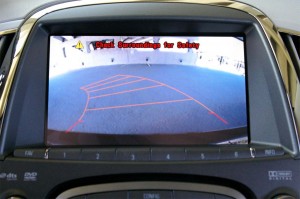
Backup cameras are becoming increasingly common but the government still aims to make them mandatory despite the latest delay.
Safety advocates have been handed another setback as the federal government yet again postpones its long-awaited backup camera mandate.
In a letter to Congress, U.S. Secretary of Transportation Ray LaHood said it will likely be as late as January 2015 before the National Highway Traffic Safety Administration can finalize rules requiring automakers to install the devices – which many believe could help save 100s of lives.
NHTSA has estimated that there are 202 backover deaths in the U.S. each year – including 100 children under the age of five. Another 14,000 Americans are injured in such incidents.
Ironically, even as regulators struggle to come up with rules acceptable to both consumer advocates and auto manufacturers, the industry is rapidly increasing the adoption of backup camera technology, Honda already laying out plans to make the devices ubiquitous as it updates its current product line-up.
“This rulemaking is important to the department due to its focus on enhancing the safety of our children,” Transportation chief LaHood stressed in a letter to Congress. In a separate interview with the Detroit News, however, he also noted that the technology is expensive, “and we just have to figure out ways to bring down the costs.”
(Chrysler gives in – but Jeep recall still smaller than Feds originally demanded. Click Here for the story.)
Due to the latest delay, it is likely the proposed mandate wouldn’t take effect until at least 2017, as a period of public comment would be required after the rules were announced and it would then take time for manufacturers to adopt the guidelines. It remains to be seen if NHTSA would phase in the backup camera rules, as the agency has often done for other safety technologies, such as airbags. If so, that could stretch the adoption timeframe out through the end of the decade.
(Tesla recalling Model S battery car due to safety defect. Click Here.)
“I am deeply disappointed by the Administration’s foot-dragging,” said Sen. Jay Rockefeller, the West Virginia Democrat who heads the powerful Commerce Committee. He plans to press the next DoT head to speed up the rule-making process. LaHood plans to leave the Transportation Dept. job next week.
When the government first outlined plans to make backup cameras mandatory it estimated they could cost the auto industry anywhere from $1.9 billion to $2.7 billion annually. Though that would be passed onto consumers, manufacturers have already been making buyers pay for the growing number of backup camera systems already being offered – whether as standard equipment or options. In fact, one estimate suggests that 80% of the new vehicles now vehicles on the road can already be ordered with the technology.
“This is a decision for consumers, not the government,” argued Gloria Bergquist, vice president for public affairs at the trade group the Alliance of Automobile Manufacturers.

Back up cameras might reduce injuries and deaths and they might not. If people aren’t smart enough to look behind the vehicle when backing up they may also not be smart enough to look at a rear view camera which displays directly behind the vehicle but not along side the vehicle which is also a concern. It’s pretty tough to replace the human eye…
The same thing – “they might reduce injuries and deaths and they might not” – was said about seat belts and air bags. “It’s pretty tough to replace the human eye?” Really, Jorge, that’s the best you can come up with? Cameras don’t “replace” anything, they’re supplements that provide vision where it would otherwise not be available.
Cameras will break, get covered with grime and not get fixed just like the radios and tape
in older cars.
Good point J.M. that’s a fact.